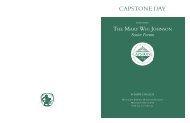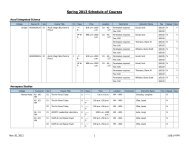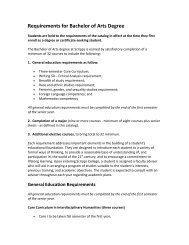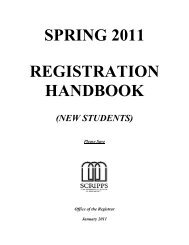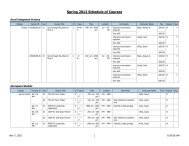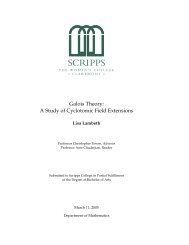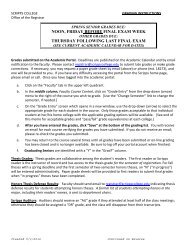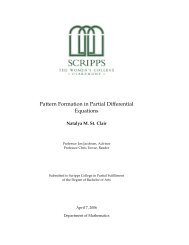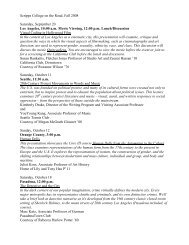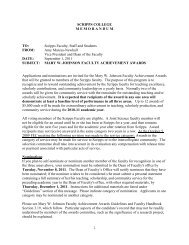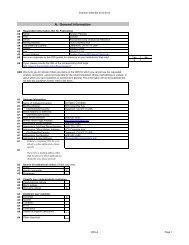final examinations - Scripps College
final examinations - Scripps College
final examinations - Scripps College
Create successful ePaper yourself
Turn your PDF publications into a flip-book with our unique Google optimized e-Paper software.
CORE III SECTION DESCRIPTIONSSection 1 (TR 9:35-10:50 a.m.)Cultural Visions Through the ArtsHow does culture shape or influence form and content in the arts? How do the arts, both visual and performing,reflect, represent, or shape culture? Do they document, protest, respond to, influence, interpret, preserve,illuminate, or forecast culture? In this course we will explore major cultural, social, political, and technologicalthemes in the 20th century as represented in existing works within the performing and visual arts. We will begin byanalyzing cultural perspectives as represented in Modern Dance choreography, and branch out into other art formsas the semester progresses. Students will investigate aspects of their own cultures and develop creative projectsthat make concrete statements about their perspectives on culture. Ms. AbramsSection 2 (TR 1:15-2:30 p.m.)The Representation of Female Identity in Renaissance ItalyA great deal of ambiguity and contradiction characterizes the representation of women in Renaissance Italy.Sometimes women were viewed as ineffectual and morally weak, to be relegated to the domestic sphere; otherviews portray them more positively as equals of men and accomplished participants in male dominated arenas. Theaim of the course is to explore the complex nature of female representation in this period by examining the viewsconveyed through male authored texts, as well as the views women themselves presented of their gender. The textsused will cover a number of areas including literature, politics, religion, art history and philosophy. We will alsosample recent insights on the part of historians and literary and feminist critics. Throughout the semester, studentswill work on a research project based on an individual female figure whose life and/or work relates to the course.They will share their findings during the <strong>final</strong> weeks of the class. Ms. AdlerSection 3 (TR 2:45-4:00 p.m.)Representations of Woman: The Virgin/Whore DichotomyOne of the common attributes of patriarchal cultures the world over is the representation of Woman as virgin or whore.This seminar addresses the social construction of the Catholic Eve/Virgin Mary polarity through an in-depth analysis ofGreater Mexico’s Virgen de Guadalupe and La Malinche. We will then examine the feminist deconstruction andredefinition of these two figures in the cultural production of contemporary Chicanas. Ms. AlcalaSection 4 (TWR 11:00-11:50 a.m.)Foreign Language and Culture Teaching ClinicThis course will explore the notion of culture and its representation as a key element of foreign languageacquisition. After two weeks of pedagogical training, students will team-teach a foreign language mini-courseincluding cultural and linguistic components to elementary school students twice a week. We will focusparticularly on the representation of culture, both in current textbooks and in the students’ own classes. We willcritique one another’s teaching performance, and discuss, compare and contrast cultural content in the variouslinguistic domains examined in the course. Students may teach any of the following languages: Chinese, Dutch,French, German, Italian, Japanese, Korean, and Spanish, or any other language proposed by at least two nativespeakers. Prerequisite: native fluency, or completion of or enrollment in an upper division course (numbered 100or higher) in the chosen language. Instructor permission is required, and permission slips will be issued on a firstcome,first-served basis. Mr. BoucqueySection 5 (MW 1:15-2:30 p.m.)Creating and Recreating GenjiAs an attendant to the empress of Japan, Murasaki Shikibu observed the public ceremonies and private intrigues ofthe Heian court and represented that elegant world in her literary masterpiece The Tale of Genji. This monumentalwork of fiction significantly influenced Japanese literature, visual arts and performing arts for the next 1000 years,with characters and events of the novel being constantly represented and recreated. In this course we willinvestigate how Genji has evolved over the centuries, reading the original novel, 11 th -century court diaries, 15 th -century “noh” plays and 18 th -century parodies, as well as viewing paintings, sculptures, films and manga. Studentshave the option of performance, exhibition, or anthology formats for their <strong>final</strong> projects. Mr. Coats13




